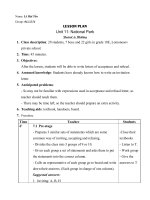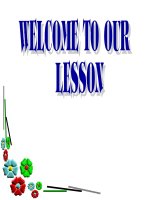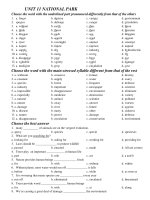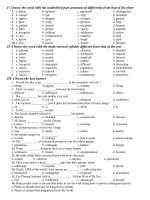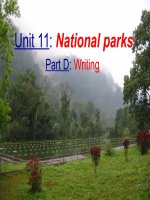Unit 11 National Park Reading
Bạn đang xem bản rút gọn của tài liệu. Xem và tải ngay bản đầy đủ của tài liệu tại đây (305.41 KB, 9 trang )
<span class='text_page_counter'>(1)</span><div class='page_container' data-page=1>
<b>LESSON OUTLINE</b>
<b>……</b>
<b>Time</b>
<b>Procedure</b>
<b>Aim</b>
<b>Focus</b>
5 min Warm-up
- To get Ss involved
- To give Ss background of
national park
T Ss
Ss Ss
7 min Pre-teaching
- Discuss
- Eliciting
vocabulary
- Check
vocabulary
- To help Ss brainstorm the
topic
- Give Ss background before
reading.
- Memory vocabulary
Ss Ss
T Ss
T Ss
18 min While- reading
1. Task1
2. Task 2
Practice scanning & guessing
meaning of words
T Ss
Ss Ss
12 min Post – reading
Interview
Practice speaking skill
Ss Ss
3 min Homework
To practice writing skill
T Ss
LESSON PLAN: READING
</div>
<span class='text_page_counter'>(2)</span><div class='page_container' data-page=2>
<b>Name of the lesson: National Park</b>
<b>Class: 10</b>th<sub> form</sub>
<b>Students in charge: Võ Thị Thu Hiền</b>
Huỳnh Thị Cẩm Loan
Bạch Thị Như Thảo
<b>Time allotted : 45 minutes</b>
<b>Aims: To help students practice reading skill:</b>
Scan for specific information
Guessing the meaning of words based on contexts
Use vocabulary items related to the topic
<b>Skills: Reading for specific information</b>
<b>Sub skill: Speaking about the topic</b>
<b>Anticipated problems: Ss may not know much about the marine life and related </b>
vocabulary, so T should be ready to give explanation.
<b>Teaching aids: Textbook, pictures, posters…</b>
<b>PROCEDURE</b>
<b>* Warm-up (5 min.): Play game “competition”</b>
T sticks the diagram of pictures on the blackboard (The diagram includes 5
pictures of animals)
T asks Ss to work in groups of 5-7 and give each group a set of five flash
cards with the names of the animals in English.
T asks Ss to look at the pictures on the diagram and match the names with
appropriate pictures.
The quickest group will go to the blackboard and can stick the names on the
answer sheet.
The group who finds the correct answer in the shortest time is the winner.
<b>* Check instructions: </b>
<i><b>T asks</b></i>
- What are you going to do?
- What will you do first?
- Who will be the winner?
<i><b>Expected answers:</b></i>
Play a game
Look at the pictures and match the
names with suitable ones.
The quickest group has correct
answers.
<b>* Lead-in: </b>
</div>
<span class='text_page_counter'>(3)</span><div class='page_container' data-page=3>
<b>Stage I: PRE-READING (7 min.)</b>
<i><b>1. Discussing the questions:</b></i>
T asks Ss work in pairs to discuss the questions following:
Have you ever been to a national park?
Can you name some of the national parks in Vietnam and in the world?
What trees and animals can you see in a national park?
T goes around providing help.
T asks some Ss to present their answers
<i><b>2. Eliciting vocabulary:</b></i>
- Rainforest (n): rừng mưa nhiệt đới Eliciting technique Translation
How do you say “rừng mưa nhiệt đới” in English?
- Tropical (a): thuộc về nhiệt đới Example
Amazon forest, Cuc Phuong forest are examples of tropical thick
forests. Do you know meaning of “tropical”?
- Establish (v): thành lập Synonym
What’s another word for “set up”?
- Toxic (a): độc Explanation
Toxic chemicals make water polluted. What does “toxic” mean?
<i><b>3. Checking vocabulary: Rub out and remember</b></i>
<b>STAGE II: WHILE-READING (18 min) </b>
<i>Setting the scene: You are going to read three passages about three national parks. </i>
While you are reading, do the tasks below:
<i><b>Task 1: Word guessing</b></i>
<b>Instruction: You are required to find the word in the passage that can match with </b>
the given definition.
1. . ………… : to have something inside
2. .………… : be situated in a place
3. …………. : a state of continuing to live or exist
4. …………. : related to an area near a tropical area
5. …………. : a state of being polluted
<b>Checking instruction:</b>
<b>T asks</b>
- What are you going to do?
- What do you do next?
<b>Expected answers:</b>
Find words in the passage
</div>
<span class='text_page_counter'>(4)</span><div class='page_container' data-page=4>
T asks Ss to read through the passage silently.
After Ss finished reading the passage, T gives Ss some strategies to do the
task.
First, read through the definition provided in the task to identify kind
of word to match each:
Ex: ………: to have something inside
<i>Should be a Verb</i>
Second, go back to the passage and find the suitable words to fill
blanks.
T goes around to help Ss (if any)
T asks Ss to check their answer in pairs
T calls Ss to present and explain their answers
T gives Ss the correct answer
<b>Answer key:</b>
<i>1. contain</i>
<i>2. be located</i>
<i>3. survival</i>
<i>4. sub-tropical</i>
<i>5. contamination</i>
<i><b>Task 2: Answering the questions</b></i>
<b>Instruction: You are to read the passage again and answer the question</b>
1. What is the area of the rainforest in Cuc Phuong National Park?
2. When should the tourists go to this park? And why?
3. What do the visitors go to the Nairobi National Park for?
4. Where is Everglades National Park located?
5. Why is Everglades National Park in danger?
T asks Ss how to do this task
T gives Ss some strategies to do the task
Skim each question to understand it.
<i>Underline the key words</i>
<i>Look for the question words. E.g., what percentage </i><i> find the </i>
<i>number</i>
</div>
<span class='text_page_counter'>(5)</span><div class='page_container' data-page=5>
Read the passage carefully to find the answer. You can use your own
word.
T asks Ss to work individually
T asks Ss to discuss their answers with their peers
T calls some Ss to write their answer on the blackboard and asks them
explain
T feedbacks and gives the correct answer.
<b>Answer key: </b>
<i>1. 200 km2 </i>
<i>2. During the dry season from October to April/ because the rainy season is </i>
<i>over </i>
<i>3. They can learn about the habits of animals, how to recognize the different </i>
<i>species of animals and plants, and how one species is dependent upon </i>
<i>another for survival.</i>
<i>4. In the southeastern United States</i>
<i>5. Because of the toxic levels of chemical in the water</i>
<b>STAGE 3: POST-READING </b>
Role-play: Interview
T draws a table on the blackboard.
Name National park(s) Reason(s)
T asks Ss to take a piece of paper and draw the table.
<i><b>Instruction 1: You are required to interview different friends to find out their </b></i>
<i>favorite national park(s) and the reasons why they like them, then complete the </i>
<i>table.</i>
<b>Checking instruction 1:</b>
<b>T asks</b>
- Is my instruction clear
enough?
- What are you going to do?
- What do you do next?
<b>Expected answers</b>
Yes
Interview
Complete the table
</div>
<span class='text_page_counter'>(6)</span><div class='page_container' data-page=6>
T asks Ss of the first row turn back to the second one, similar to the third
row.
<i><b>Instruction 2: All of you will interview the opposite partner, and then each of you </b></i>
<i>in the second and fourth rows will move to the next position to make another </i>
<i>interview. </i>
<b>Checking instructions 2:</b>
<b>T asks</b>
- Who belongs to the first and third
rows, raise your hands?
- Do you move after making an
interview?
- Ss of the second and fourth rows,
what will you do after each
interview?
<b>Expected answers</b>
Ss raise their hands
No
Move to the next position
Very good, let’s start.
After finishing the interviews, T calls some of Ss to report their findings in
front of the whole class.
<b>HOMEWORK</b>
: Write a passage using the information about their friend(s) when Ss make
interviews in class
Prepare for new lesson.
</div>
<span class='text_page_counter'>(7)</span><div class='page_container' data-page=7>
<b>P1</b>
<b> P2 P3</b>
<b> P4 P5</b>
<b>2. Answer sheet:</b>
<i> Group 1 Group 2 Group 3 Group 4 </i>
</div>
<span class='text_page_counter'>(8)</span><div class='page_container' data-page=8>
<b>3. Answer key for warm-up:</b>
<b>4. Text for while-reading</b>
P1. ………….
P2. …………..
P3. …………..
P4. …………..
P5. …………..
P1. ………….
P2. …………..
P3. …………..
P4. …………..
P5. …………..
P1. ………….
P2. …………..
P3. …………..
P4. …………..
P5. …………..
P1. ………….
P2. …………..
P3. …………..
P4. …………..
P5. …………..
</div>
<span class='text_page_counter'>(9)</span><div class='page_container' data-page=9>
<b>Unit 11 </b>
<b>NATIONAL PARKS</b>
<b> </b>
<b>A. READING</b>
<b>Cuc Phuong National Park, Vietnam</b>
Cuc Phuong National Park is located 160
kilometres south west of Hanoi. It is the
first of Vietnam’s nine national parks to be
established, and it contains over 200
square kilometres of rainforest. Tourists go
there to study butterflies, visit caves, hike
mountains and look at the 1,000-year-old tree. The best time to visit the
park is during the dry season, from October to April, when the rainy
season is over.
<b>Nairobi National Park, Kenya</b>
Nairobi National Park is Kenya’s smallest
park, but you may be surprised at the large
variety of animals that live there. Visitors,
especially children, can go there to learn
how to recognize the different species of
animals and plants. They also learn about
the habits of animals and how one species is
dependent upon another for survival. An interesting feature of this park
is the Orphanage, where lots of orphaned or abandoned animals are
taken care of.
<b>Everglades National Park, USA</b>
Everglades National Park is a sub-tropical
wilderness in the southeastern United
States. This national park is special
because it has plants and animals from
both tropical and temperate zones. Due to
</div>
<!--links-->
